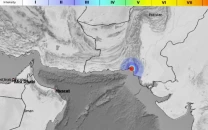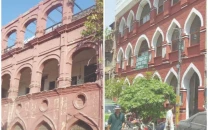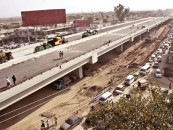Development priorities: Questions raised over economic corridor route
Government denies changing route, PPP Senator Farhatullah Babar raises alarm over plan

Government denies changing route, PPP Senator Farhatullah Babar raises alarm over plan. STOCK IMAGE
The uproar began in the Senate when members from Balochistan and Khyber-Pakhtunkhwa accused the Nawaz Administration of changing the originally proposed route – which was meant to pass through Dera Ismail Khan, Zhob and Quetta before reaching the Gwadar deep seaport – to a route that would pass through Hasanabdal, Lahore, Multan, Sukkur, Hyderabad and Ratodero.

The former route would have dramatically improved the transportation infrastructure of the two western provinces, but the latter route would improve the already better-off infrastructure in Punjab and Sindh.
At a press conference in Islamabad on Friday, Planning Minister Ahsan Iqbal denied that any changes had been made to the original plan, agreed to between Beijing and Islamabad in August 2013. Iqbal went so far as to accuse those criticising the government of engaging in “economic warfare” against Pakistan and trying to sabotage the upcoming visit of Chinese President Xi Jinping to Islamabad.
When the government first made a policy announcement about the matter in June 2014, it aroused no agitation from the opposition. The issue appears to have come to the fore once again after a group calling itself “Justice for Pashtuns” started circulating maps on Facebook and Twitter, saying that Balochistan and Khyber-Pakhtunkhwa were being excluded from the new corridor. Iqbal referred to those maps as fake.
The China-Pakistan Economic Corridor is meant to link the western regions of China to the port at Gwadar, as part of China’s desire to economically develop its hinterlands. In return, Islamabad wants $45 billion in financing from Beijing to fund several infrastructure projects across Pakistan, not just those linked to this corridor.
Iqbal said that the plan calls for not one but three corridors – an eastern, a central and a western route. In the short term, the existing transportation infrastructure would be used to make Gwadar Port functional, said National Highway Authority Chairman Shahid Tarar. Iqbal added that the alignments of the routes have not yet been confirmed and are subject to technical feasibility studies. He promised that Balochistan’s hinterlands would get their fair share of development projects as part of the corridor.
Earlier, PPP Senator Farhatullah Babar questioned the government’s decisions during a meeting of the Senate Foreign Affairs Committee. He said that the decision for the corridor’s route is a political one that should be taken by the elected representatives of the people, not civil servants.
Babar’s main criticism with the plan to have different short-term and long-term routes was that the supposedly short-term route would soon develop its own set of vested economic interests from parties that would then seek to prevent the long-term routes from ever being built. “Thus for all practical purposes the new alignment will become final and irrevocable,” he said.
He dismissed the notion that the question over which route should be developed was a purely technical one, arguing that connecting lesser developed areas of Khyber-Pakhtunkhwa and Balochistan to the nation’s economic mainstream should be a policy priority for the government.
Babar then posed three very specific questions to the NHA chairman.
1. What additional projects would be required, and at what cost, to go ahead with the initially planned route that was meant to pass through Mianwali, DI Khan, DG Khan, Khuzdar and Turbat?
2. How much of that additional infrastructure required for the additional route has already been included in the development budget? In other words, what is the marginal cost of sticking to the original route?
3. How much time will it take to make the originally planned route fully operational?
The NHA chairman promised to respond to these questions within one week. He also said that Gwadar Port is expected to become operational by May of this year, when the Ratodero-Gwadar road is completed.
Meanwhile, the dates for the Chinese president’s visit have yet to be finalised, though the Foreign Office confirmed on Friday that Chinese Foreign Minister Wang Yi is expected to visit Islamabad soon, which is widely seen as a preparatory visit to the Chinese President’s arrival. An earlier trip by the Chinese President, scheduled for August 2014, was cancelled due to the massive protests in Islamabad led by the opposition PTI.
Published in The Express Tribune, February 7th, 2015.



















COMMENTS
Comments are moderated and generally will be posted if they are on-topic and not abusive.
For more information, please see our Comments FAQ